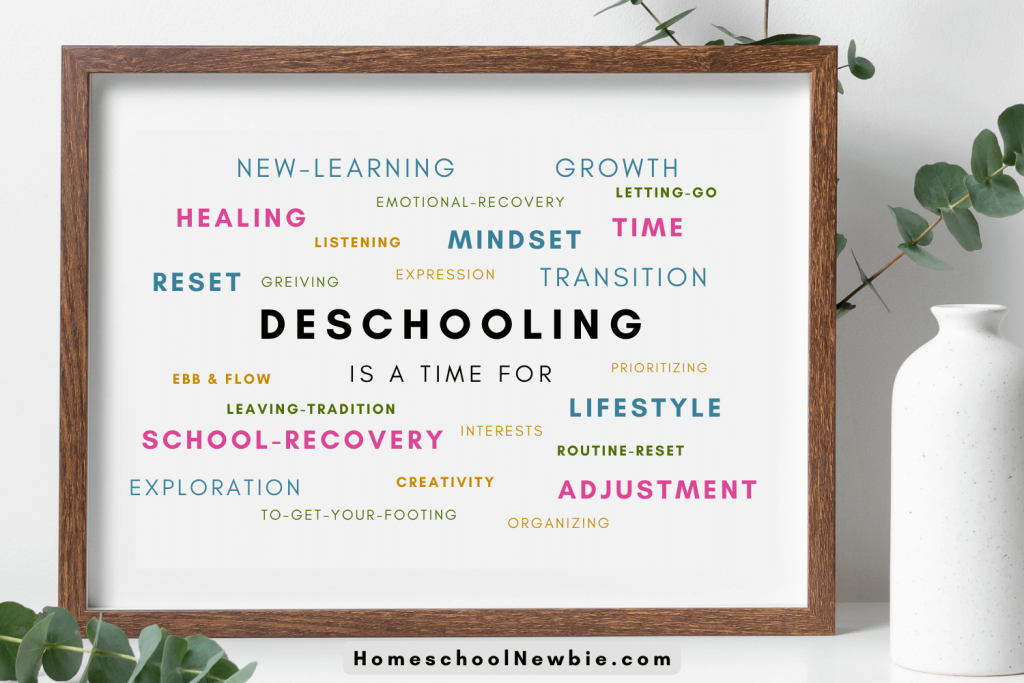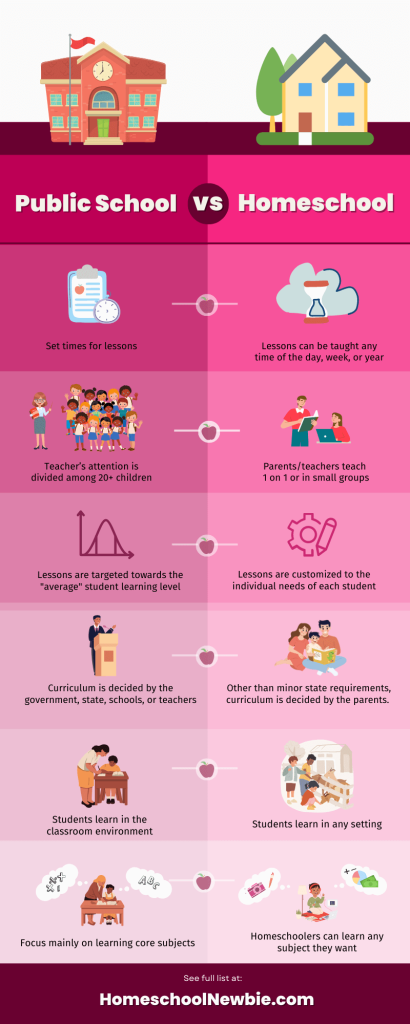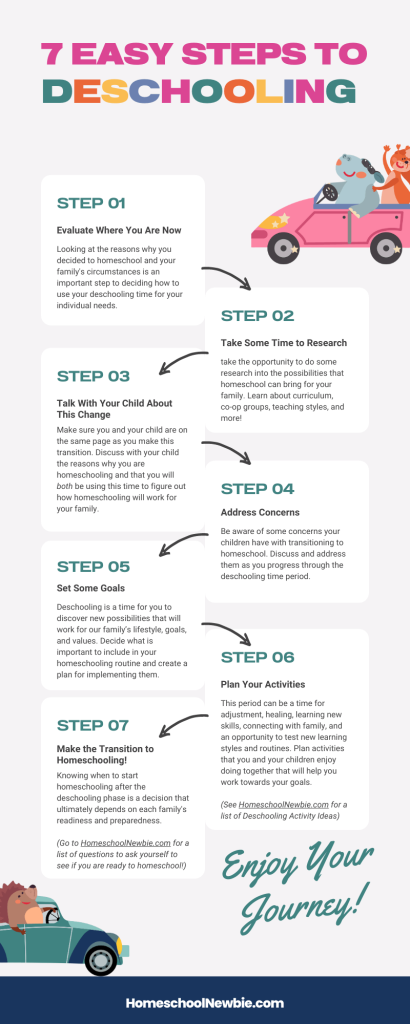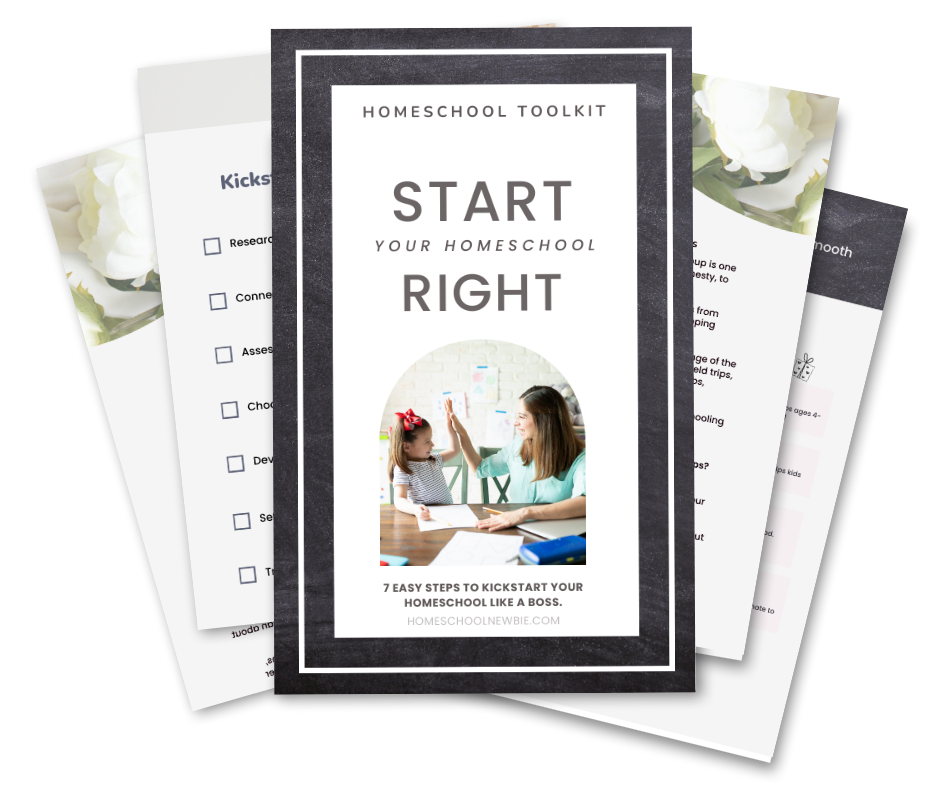Discover the secrets to a successful transition to homeschooling by finding answers to these important questions: “What is deschooling?” and “How to deschool?”.
Avoid feeling stuck by learning effective activities to do during the deschooling phase. Below you’ll discover how to tell when you are ready to move on from the deschooling phase and begin your homeschooling journey.
Table of Contents
What Is Deschooling?
A basic deschooling definition: Deschooling is a recovery time period parents and children take to let go of mindsets that were established from traditional classroom settings.
It’s a time to transition, heal, and adjust to mindsets, routines, and expectations more appropriate for a homeschool learning environment.

Deschooling is a process of transitioning from traditional educational mindsets to a new way of learning.
It involves taking a break from the routines, expectations, and pressures of traditional schooling and allowing both parents and children to adjust to the new lifestyle of homeschooling.
By letting go of old habits and mindsets, deschooling creates space for new and more effective ways of learning to emerge, which can ultimately lead to a more enriched and personalized homeschooling experience.
Public School vs Homeschool: How are they different?
While both the classroom and homeschool aim to provide education, they differ in their settings, routines, and expectations.
As a homeschooling mama who was once a public school teacher, I can see firsthand the differences that come from each of these settings.

Here Are Some Differences Between Public School Vs Homeschool:
| PUBLIC SCHOOL | HOMESCHOOL |
| There is a set time each day for lessons. | Lessons and learning can happen any time of the day, week, or year. |
| Direct instruction is typically the main teaching style. Where the students listen to the teacher give a lesson and then practice what they’ve learned. | Homeschool parents can focus on teaching 1 on 1 or small group lessons. |
| The curriculum is decided by the government, state, schools, or teachers | The lessons are customized to the individual needs of the students. |
| Other than minor state requirements, the curriculum is decided by the parents. | Other than minor state requirements, curriculum is decided by the parents. |
| Students learn in the classroom environment. | Other than minor state requirements, the curriculum is decided by the parents. |
| Teachers and students encounter many interruptions and distractions during lessons. | Parents can create a learning environment with fewer distractions because their lessons are 1:1 or with siblings/co-op groups. |
| Students must follow the rules & values decided by the teacher. | In most cases, parents don’t have to report formal testing. This means parents are free to teach based on learning. |
| Instruction and learning are influenced by state testing. | Direct instruction is typically the main teaching style. Where the students listen to the teacher give a lesson and then practice what they’ve learned. |
| Subjects are covered for an allotted time frame during the school year. | Parents can accommodate the learning speed of their children depending on their needs. |
| The focus is mainly on learning core subjects. | Homeschoolers can learn any subject they want in addition to the core subjects. |
| Students are evaluated based on a grading scale. | Some may choose not to use grading scales to measure progress. They can use projects, portfolios, mental notes, participation, and more informal ways of measuring progress. |
| In many cases, students progress through subjects and grade levels whether they are ready for them or not. | Homeschoolers can move through subjects at the pace they are ready for without comparison to other peers. |
| Direct instruction is typically the main teaching style. Where the students listen to the teacher give a lesson then practice what they’ve learned. | There are many different teaching and learning styles that homeschoolers use. Each family is different depending on their lifestyle, preference, and needs. |
Because many parents and students, like myself, were raised knowing only traditional education methods, we are tempted to bring those same routines and expectations into our homeschools.
When I decided to leave teaching in public school and homeschool my son, I relied heavily on the advice of other homeschool parents in my community.
With their help, I learned a lot about how there isn’t just one way to learn. As parents, we get to decide what education looks like in our homes!
But the biggest piece of advice that stuck with me was… “DON’T try to bring public school into your homeschool. It doesn’t work.”
This is why many new homeschooling families understand the importance of taking time to deschool themselves and their children before jumping straight into homeschool learning full force.
How to Deschool?
In this section, you learn how to go from doubt and fear to possibilities and success through the deschooling process.
First, we’ll explore how to transition from traditional education to homeschooling.
Then, I’ll provide you with real-world examples of activities you can do during your deschooling process.
Finally, we’ll explore how to tell when you are ready to take the leap from deschooling to start homeschooling!
Let’s dive in. ↓

How to Switch to Homeschooling from Public School
Making the switch from public school to homeschooling can be a big decision, but it can also be a rewarding one.
Whether you’re making the change due to a desire for a more individualized education or because of external circumstances, it’s important to know how to make the transition as smooth as possible.
Here is where to start!
Step #1 to Deschooling:
Evaluate where you and your child are now
Many families make the transition to homeschooling because of various reasons. These reasons will have an influence on how you organize your own homeschool routines.
- You want more influence in your child’s education, social life, or values.
- You or your children have had a major life change such as divorce, health problems, death, job loss or change, or moved.
- Public education wasn’t meeting the needs of your family.
- Your child was having social problems such as bullying, safety, or self-confidence concerns.
- You and your children have ambitious or customized goals that public schools don’t emphasize such as entrepreneurship, extra-curricular interests, religion, social-emotional skills, life skills, and more.
Step #2 to Deschooling:
Take some time to research
The first step is to take a short break from what you’ve known about education and do some research into the possibilities homeschooling can have for your family.
Ideas of topics to research for creating your homeschool culture, routines, and mindsets.
- Learning styles popular for homeschooling families such as unschooling
- Explore different types of curriculum
- Learn about teaching and learning with a growth mindset
- Organize your homeschooling supply list
- Get involved with homeschool co-op groups
- Look at other homeschooling family’s learning routines to inspire yours
Step #3 to Deschooling:
Talk with your child about this change
It is important for both you and your children to be on the same page as you make this transition to homeschooling during the deschooling process. Discuss with your child the reasons why you are homeschooling.
Discuss together that you will both be learning and figuring out how homeschooling will work for your family for a time.
Step #4 to Deschooling:
Deschooling Children: Address Concerns
You may have a golden child who skips off to homeschool with no resistance, but many of us may need to be aware of some concerns our kids may have with transitioning to homeschool.
Concerns Children May Encounter:
- Children asking to go back to public school.
- They are resistant to working on their curriculum at home.
- They don’t respect you as their teacher. “My teacher didn’t do that at school!”
- They’ve heard of homeschooling stereotypes and don’t want to be labeled with them.
- They are nervous about making new friends and worried about losing old friends.
- Need help with self-initiation because they are used to teachers telling them what to do and learn.
- They left a tough situation at school and need time to heal.
- They don’t take schoolwork seriously in their new homeschool setting.
Even though the issues above can be intimidating, I’ve listed below some ideas for you and your children to do to make the deschooling process smooth, healing, and prepare you for a successful homeschooling experience.
Step #5 to Deschooling:
Deschooling for Parents: Set Goals
Yes, even we parents need to deschool! We all have our biases on what education should look like and oftentimes, it doesn’t always translate well into our new homeschool lifestyle.
Deschooling is a time for us parents to discover new possibilities that will work for our family’s lifestyle, goals, and values.
Use this deschooling period to decide what is important for you to include in your homeschooling routine. Then create a plan for implementing them.
Use the activity ideas below to help you start organizing and practicing the goals that you set.
Step #6 to Deschooling:
Deschooling Ideas: What to do during the Deschooling Period?
During the deschooling phase, parents and children are transitioning from traditional educational mindsets to becoming ready for homeschooling.
This period can be an adjustment, a time to heal, an opportunity to test new learning styles and routines, and a time to connect with family and learn new skills.
Below, we’ll explore more ideas of what you can do during the deschooling phase to make the most of this transition period.
- Take a break: Deschooling is a time to take a break from the traditional classroom setting and routine. Take some time to relax, unwind, and enjoy life outside of school.
- Reconnect with your child: Spend time with your child without many academic expectations. Do things you both enjoy, like going on hikes, playing board games, or cooking together.
- Reflect on your educational philosophy: Take some time to reflect on your values and beliefs about education. Consider how you want to approach homeschooling and what goals you have for your child’s education.
- Explore new interests: Use this time to explore new interests and hobbies. Encourage your child to explore their passions and try new things.
- Read books: Read books about homeschooling, education, and parenting to gain new insights and ideas. Also encourage your children to read by going to the library, finding audio books, or reading together.
- Attend homeschooling conferences and events: Attend homeschooling conferences and events to connect with other homeschooling families and learn about different homeschooling approaches and resources.
- Take educational trips: Take educational trips to museums, historical sites, and other places of interest. Use these field trips to learn about different subjects in a hands-on and interactive way.
- Develop a homeschooling plan: Use the deschooling period to develop a homeschooling plan that aligns with your educational philosophy and goals.
- Encourage independent learning: Encourage your child to pursue independent learning and explore topics that interest them.
- Foster a love of learning: Use the deschooling period to foster a love of learning in your child. Focus on making learning fun, engaging, and relevant to their interests and passions.
- Help with chores and cooking around the house: Teach your child valuable life skills by involving them in household chores and cooking.
- Spend time connecting to relatives: Use the deschooling period to spend more time connecting with family members such as grandparents, cousins, aunts, and uncles. Try gathering either in person, writing letters, or chatting through video calls.
- Engage in unstructured play: Encourage unstructured playtime for your child, allowing them to explore and create without any academic constraints.
- Volunteer or participate in community service: Get involved in community service activities or volunteer work with your child to promote social responsibility and community engagement.
- Practice mindfulness and relaxation techniques: Incorporate mindfulness practices, meditation, and relaxation techniques to promote mental and emotional well-being during the deschooling period.
- Spend time outdoors: Spend time outdoors, in nature, and explore the natural world. Use this time to learn about science, nature, and ecology.
- Watch documentaries: Watch educational documentaries with your child to learn about different cultures, science, history, and other topics of interest.
- Foster a growth mindset: Focus on promoting a growth mindset in your child, emphasizing the importance of effort, persistence, and resilience.
- Connect with other homeschooling families: Connect with other homeschooling families through social media, online forums, or local homeschooling groups to share resources and support.
- Experiment with different teaching methods and styles: Use the deschooling period to experiment with different teaching methods, such as project-based learning, inquiry-based learning, or experiential learning. Also look into homeschooling styles like unschooling, eclectic, or unit studies.
- Encourage creativity and innovation: Provide opportunities for your child to engage in creative and innovative projects, such as inventing, designing, or building.
Step #7 to Deschooling:
Transitioning from Deschooling to Homeschooling: Signs You’re Ready
If you can answer most of the questions below with a “yes”, this is a sign you and your children may be ready to make the jump into homeschooling.
- Do I recognize that homeschooling requires a significant time commitment?
- Have I researched different homeschooling methods to find the best fit for my family?
- Do I have a support system in place, such as a local homeschool group or online community?
- Am I willing to be flexible and adjust my teaching approach as needed to meet my child’s learning needs?
- Have I set realistic goals for my child’s education and am I prepared to track their progress?
- Has my relationship with my child strengthened and have we begun to build trust?
- Am I comfortable with the legal requirements and regulations for homeschooling in my state or country?
- Do I have a plan for socialization and building relationships with peers outside of traditional school settings?
- Have I considered my own personal and professional goals, and how homeschooling will fit into my lifestyle?
- Have we experimented with different homeschooling routines and found one that works for our lifestyle?
- Do I have the necessary resources and materials to begin homeschooling, such as curriculum, supplies, and equipment?
- Have I discussed and gained the support of my spouse or partner, and any other important stakeholders in my child’s education?
Homeschooling is a learning style that is flexible, ever-changing as your needs change, and unique for every family.
Trust your instincts to know when you FEEL ready to begin homeschooling. However, no one is going to be 100% prepared or confident when starting to homeschool.
The important thing is that you do what you can to prepare then take the leap and adjust as you move through your homeschooling journey together.
How Long Does Deschooling Take?
The length of time for deschooling can vary depending on the family’s individual circumstances and needs.
Some families may need a few weeks to a few months to fully transition and adjust to homeschooling, while others may need a longer period of time.
Additionally, deschooling is not necessarily a fixed period of time, but rather a transition period that can continue throughout a family’s homeschooling journey.
Ultimately, the length of time for deschooling will depend on the family’s unique situation and their goals for homeschooling.
When to Start Homeschooling?
Knowing when to start homeschooling after the deschooling phase is a decision that ultimately depends on each family’s readiness and preparedness. There are no hard and fast rules about when to start homeschooling, as each family’s situation and circumstances will differ.
That said, there are a few signs that may indicate a family is ready to transition from the deschooling phase to a regular homeschooling routine.
What’s Next?
Feel like you need a little more support for getting started with homeschooling? I’ve created an free easy 7 step guide for you to help you to get your homeschool started the right away.

Grab your FREE Homeschooling Kickstarter Guide and get your homeschool started on the right foot.
Conclusion: What is Deschooling & How To Deschool?
Deschooling provides time for you and your children to adjust to a new lifestyle and let go of the old expectations of traditional schooling.
Take advantage of this transitional time with your kids as you learn, plan, grow, and bond together.
Read Next: What is Unschooling and How to get started?
Wondering about homeschooling teaching styles? Learn from an expert unschooler! I’ve interviewed an experienced unschooling parent to show you a unique way to teach your children by using your children’s interests and passions.
Learn what unschooling is and how you can unschool from this insightful interview.

Hi, I’m Courtney! I’m the founder of homeschoolnewbie.com. I’m a former elementary school teacher turned homeschool mama who has a passion for home education! I have 10+ years of experience working with children in all kinds of educational settings. As a new homeschooling parent, my mission is to navigate the world of homeschooling and share with you the best home education practices. If you want to learn more about me, check out my about page. See you there!

